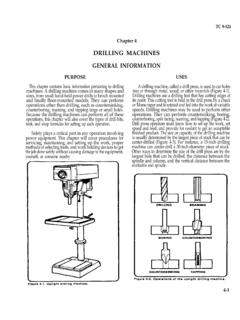Transcription of DIRECTION SENSING INFRARED MOTION …
1 DIRECTION SENSING . INFRARED MOTION . DETECTOR. MANUAL. GLDIR MOTION DETECTOR. GLOLAB. CORPORATION. Glolab does not offer a kit of parts for this project. We sell the PIR325 pyroelectric INFRARED sensor and FL65 Fresnel lens. Other parts are available from electronic parts distributors. The goal of Glolab is to produce top quality electronic kits, products and components. All of our kits are designed by Glolab engineers and tested in our laboratory. Mechanical devices, prototypes and enclosures are fabricated in our precision machine shop. Glolab Corporation has two locations in New York's Hudson Valley. Our electronics laboratory and kit packaging is located in Wappingers Falls and our machine shop is in Lagrangeville. In addition to our kits and RF modules, we supply some special and hard to find parts such as our Pyroelectric INFRARED Sensor and INFRARED Fresnel lens for those of you who want to design and build your own projects.
2 Technical help is available by email from Copyright 2003. Glolab Corporation 307 Pine Ridge Drive Wappingers Falls, NY 12590. 2. GLDIR _____. Description The GLDIR DIRECTION SENSING MOTION detector is X inches with circuit components on one side and a pyroelectric INFRARED sensor on the other side. The board should be mounted with the inch dimension vertical for maximum sensitivity to horizontal MOTION . Four holes on the corners accept # 4 mounting screws. A Fresnel lens or other focusing device can be placed in front of the sensor to increase SENSING distance by focusing INFRARED radiation onto the sensor elements. Sensitivity The component side of the GLDIR has a sensitivity adjustment R10 that controls amplifier gain and therefore range (detection distance).
3 Turning the adjustment clockwise increases sensitivity and gives a greater range. The pyroelectric INFRARED sensor in the GLDIR will detect a human or animal more easily at lower ambient temperatures when there is a greater difference between the human or animal body temperature and surrounding objects. Time that load remains on Single shot circuits control the amount of time that a load remains turned ON after MOTION is detected. ON time can be varied from second to about 10 seconds by adjusting R15. The single shots are re-triggerable so that continued MOTION will extend the ON time. Power A 6 to volt battery will power the circuits. Power is connected to the GLDIR solder pads marked PWR, + and . The circuits draw less than 150 microamperes.
4 A nine volt alkaline battery should power the MOTION detector circuits for several months and possibly much longer. The power system is reverse polarity protected so that a reversed power source will not damage the circuits. A DC wall transformer may also power the GLDIR, however most wall transformers output much higher than their rated voltage when lightly loaded so the transformer output should be measured to be sure that the volt maximum GLDIR power supply input is not exceeded. Capacitors in the amplifier and timing circuits require time to charge up to their normal operating voltages before the circuits will operate correctly. The circuits will not respond to MOTION until about one minute after power is applied. 3. Pyroelectric Sensors The sensor has two elements connected in a voltage-bucking configuration.
5 This arrangement cancels signals caused by vibration, temperature changes within the sensor and sunlight. An animal passing in front of the sensor will activate first one and then the other element as shown in figure 1 whereas other sources will affect both elements simultaneously and be cancelled. The radiation source should pass in a horizontal DIRECTION so the elements are sequentially exposed to the IR source. The sensor also has a built-in INFRARED filter window. The output signal from the sensor will transition first positive and then negative, or first negative and then positive, depending on which sensor element is exposed to radiation first. FIGURE 1. Sensor characteristics The sensor will respond to a moving body only; it will not detect a stationary INFRARED source, however it is very sensitive to changes in air density close to the front of sensor and might produce false responses if not covered by a lens or IR transparent window.
6 The detection range without a lens is about three feet but can be extended to up to 90 feet or more by placing an INFRARED Fresnel lens in front of the sensor. A Glolab FL65 INFRARED Fresnel lens with a focal length of inch is recommended for longest range. The lens can be mounted in an enclosure with its grooves facing inside, using silicone rubber adhesive around the mounting flange. The GLDIR should be mounted with the FL65 lens spaced inch from the sensor. 4. How the GLDIR works_____. Amplifier and comparator Figure 2 is a circuit diagram of the GLDIR. Power is supplied to the circuits through micropower 5 volt regulator IC3. The 5 volts from the regulator is further filtered through R2, C2 and fed to pin 1 of the PIR325 pyroelectric sensor.
7 The signal output at pin 2 of the sensor is bypassed to ground by a 100pf capacitor C1 to shunt any RF energy that might be picked up from radio transmitters or cell phones. A 100K load resistor R1 is also connected from pin 2 to ground. When MOTION is detected the sensor will output a very small voltage transition at pin 2. This voltage must be amplified many times in order to do useful work. Two sections of a LP324 or equivalent quad operational amplifier are used to provide the necessary amplification. Sensor pin 2 feeds into the first stage amplifier IC1A at non-inverting input pin 3. This is a very high impedance input and does not load the sensor. A high pass filter and feedback network, R4, C4 connects from IC1A output pin 1 to inverting input pin 2 and a high pass filter and bias network, C3, R3 connects from pin 2 to ground.
8 These networks set the amplifier gain and operating point and also form a bandpass filter that amplifies only signals above DC and below about 10Hz. The pyroelectric sensor is a thermal device and its response time falls within this band of frequencies. Filtering out signals outside its response time eliminates noise sources from frequencies that are not used anyway and makes the amplifier more stable. The output of the first amplifier stage, IC1A is taken from pin 1. It then feeds through R5 and C5 into the inverting input of the second amplifier stage at pin 13 of IC1B. C5 blocks the flow of DC and, together with R5, forms a high pass filter to reduce gain at very low frequencies. A. feedback network R10, R11, C6 connects from IC1B output pin 14 to inverting input pin 13.
9 R10 is a potentiometer that controls the amount of feedback and therefore the gain of this stage. R11 limits the amount of feedback. The non-inverting input to IC1B at pin 12 is biased to of the supply voltage or volts by resistor divider network R6, R7, R8, R9. This bias sets the operating point of the amplifier so that its output pin 14 is at volts when no MOTION is being detected. The output of IC1B pin 14 feeds into a window comparator made of IC1C and IC1D. When an operational amplifier is used as a comparator It is run at full open loop gain so that its output switches to a full up or down level when one input is just a few millivolts higher or lower than the other. The purpose of this comparator is to provide a small voltage window or dead zone centered around volts that will not respond to small voltage transitions caused by noise or minor fluctuations from the sensor.
10 The inverting input of IC1C at pin 9 is biased by the voltage at the junction of R6, R7 so it is about 175 millivolts above the volt output level at pin 14 of IC1B, and inverting input pin 10 of IC1C is connected to IC1B pin 14. IC1C will not turn on until pin 10 goes more positive than pin 9. The non-inverting input at pin 5 of IC1D is biased by the voltage at the junction of R8, R9 to about 175 millivolts below the volt output level at pin 14 of IC1B, and inverting input pin 6 of IC1D is connected to IC1B pin 14. IC1D. will not turn on until pin 6 goes more negative than pin 5. 5. When MOTION is detected and the voltage transition at the output of second stage amplifier IC1B pin 14 is positive it must go more that 175 millivolts above volts or volts in order to turn IC1C on so that its output will transition to a high level.








